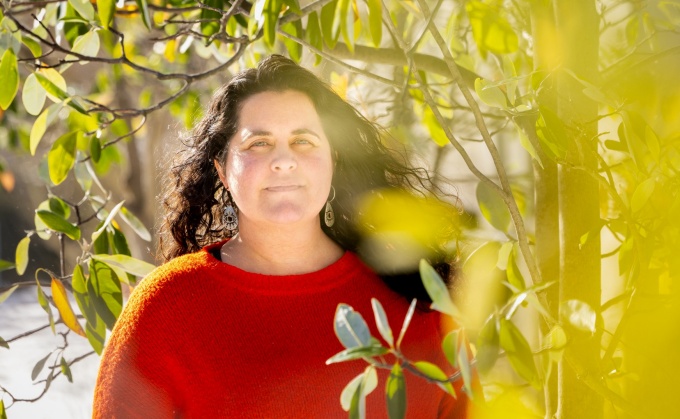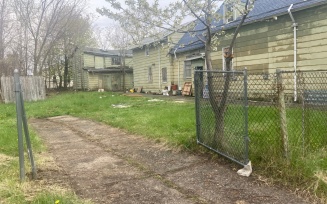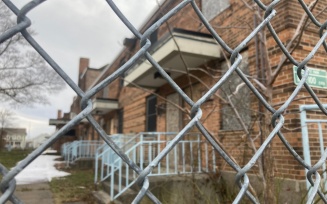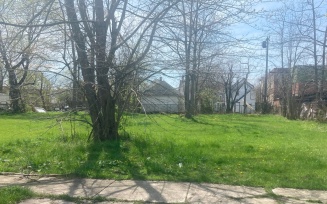“It’s the roots that need water”
The process and potential of a community-based dissertation
Nicole Capozziello, PhD ’25, MSW ’20. Photo: Meredith Forrest Kulwicki.
By Nicole Capozziello, PhD ’25, MSW ’20
I first learned of tree equity in 2022, when a conference presenter quoted the nonprofit American Forests, saying, “A map of tree coverage in the United States is too often a map of income and race.”
As a PhD student, I was no stranger to inequity: studying it academically, working with people experiencing it and seeing it virtually everywhere. However, that inequity extended to the trees above our heads was a revelation — and one I couldn’t forget.
These words echoed in my head as I walked around Buffalo’s West Side, biked to work at Grassroots Gardens of Western New York on Broadway, east of Main, and drove to community gardens across the city. Wherever I went, I took stock of the trees: if they were there, what kind, their age, their health.
Not only did tree cover take on more meaning — and become an indicator of equity — but so did parks and the vacant lots I’d become all too accustomed to. I wondered how others experienced these things and if they too noticed blocks without trees, felt demoralized by vacant lots or went out of their way to pass a rosebush in bloom. These thoughts percolated in my mind as I refined the idea for my dissertation project.
Since beginning the School of Social Work’s MSW/PhD program in 2018, I had heard the adage “a good dissertation is a done dissertation” countless times. It was a reminder to not get hung up on perfection. Beyond done, however, I wondered how my dissertation could be meaningful and make an impact. I knew I didn’t want to produce something that was only interesting to me or within academia, but honing what I wanted to do was a challenge.
Over lunch, the late community leader Gail Wells, who later became a study participant, told me: “People know they want their neighborhoods to be better, to be different, but we don’t paint a picture broad enough of what spaces could be. If you can’t imagine something, how can you build it?” Gail’s visionary outlook compelled me to go beyond examining problems and center the act of exploring possibilities in my research.
Other people’s experiences of research as tedious or extractive motivated me to create a process that would be enjoyable, with outputs that participants could see themselves in. To this end, I began by giving participants the option to use their real name and be identifiable in photos.
As I developed my dissertation project, I was fortunate to have a committee — composed of my chair Elizabeth Bowen and Mickey Sperlich, associate professors in the School of Social Work, and Lourdes Vera, assistant professor in the College of Arts and Sciences — that encouraged the community-based and creative elements of my study.
My ideas ultimately became “‘It’s The Roots That Need Water’: A Community-Based Case Study Exploring Buffalo East Side Residents' Experiences of Nature and Vacant Land.” Through interviews, neighborhood walking tours and a participatory design studio, I asked East Side residents to reflect on their experiences of nature past and present, as well as their visions for the future.
Some of the study’s findings were predictable, such as the role of nature in people’s well-being throughout their lives. People vividly recalled playing in parks, eating fruit from Masten's bountiful trees and learning to garden.
Other results were unexpected and complex. For instance, I was surprised by the omnipresence of gentrification, as both a lived experience and concept. Lorraine, who had lived most of her life in the Cold Springs neighborhood, told me: “No matter if it’s Buffalo, Philadelphia, Detroit, they’re all the same issues. Because living where we live — the city — it’s fine real estate. And little by little, we are being squeezed out.”
Participants also lived with a constant tension between hope for their communities and cynicism after years of dealing with the city. Gerldine, an East Side resident for over 20 years, expressed, “In an ideal world, you'd want a city that would understand that it's better to have a community garden or a group of neighbors that are working on a property than to just leave it.”
I was constantly awed by the thoughtfulness of participants who generously and enthusiastically guided me through their memories, neighborhoods and hopes. When I went back to share preliminary results and ask for feedback, a practice called member checking, our conversations were full of clarifications, additions and follow-up with relevant resources.
Though its impacts are still emerging, I am proud to say that my dissertation is both done and meaningful. I hope this work will contribute to a better understanding of East Side residents’ experiences, fuel the adoption of comprehensive vacant lot policy and create more opportunities for genuine collaboration among community members and researchers, urban planners, politicians and others.
Whether it’s a community-based dissertation, better policy or a community garden, creating something is hard work that’s only possible with connection and creativity. And, as Gail showed me, there is value in both imagining and building.
During walking tours with her participants, Capozziello took photos to document her research. Pictured, from top, are an East Side lot, the abandoned Willert Park housing project and a lot in the Broadway-Fillmore neighborhood.




